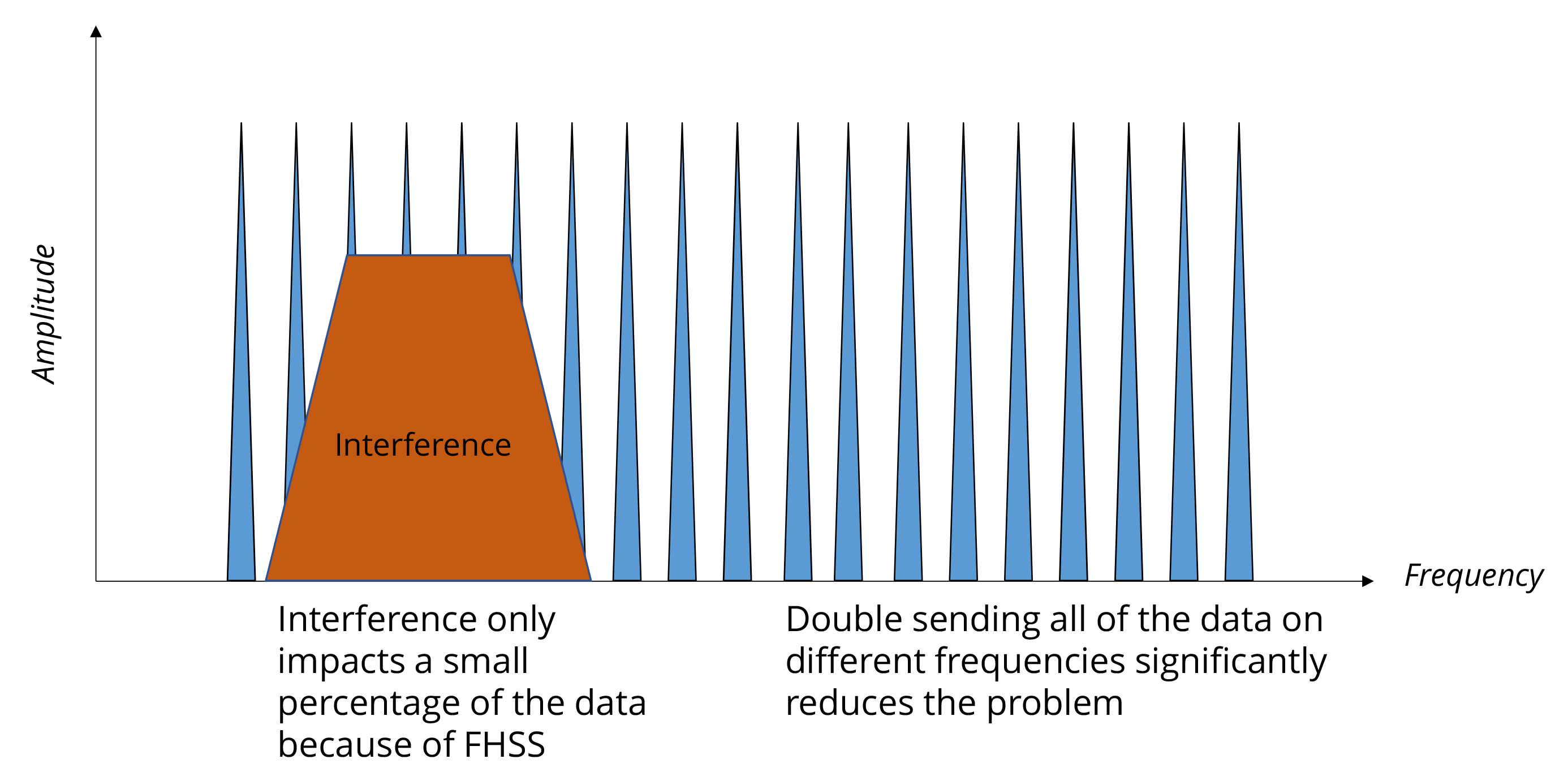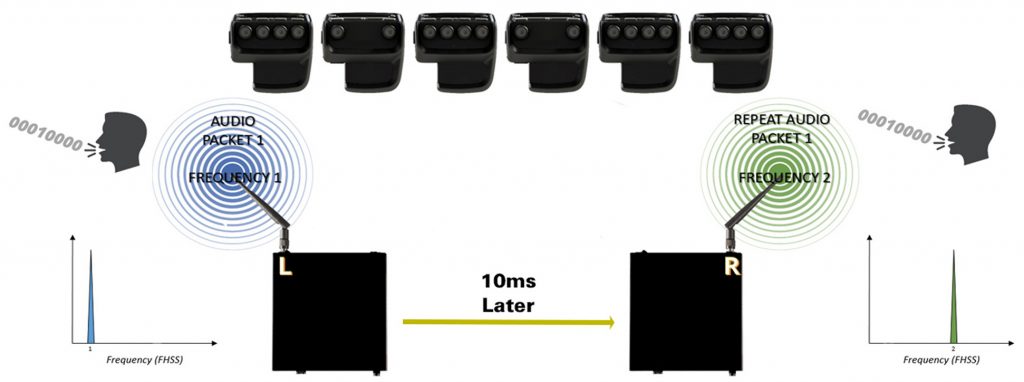Anyone who uses any form of wireless or RF technology for today’s applications understands that critical wireless communication has become increasingly difficult, regardless of where you work and regardless of the nature of the application. The constantly increasing demands from productions for more RF devices, in less available RF space, means the task of getting wireless devices all running and working together can be a big headache. This is true both for fixed installations and for temporary events that need wireless for a few days…or just a few hours.
It’s not uncommon to use wireless microphones (RF mics), wireless in-ear monitors (IEM), wireless lighting control systems, wireless musical instrument connectivity, wireless talent cueing (IFB), wireless video cameras and wireless intercoms for a single application. Just a few years ago, back when the world of RF was simply analog, there were basic rules that everyone followed—all was good. It was a complex, but achievable, task to get devices working together. Generally, one person received all the requests for the devices to be used, coordinated the devices and their respective frequencies, and put out the list of who was authorized to use which devices on what frequencies.
Then came the digital age, and the value of the frequencies we use daily increased exponentially. The demand was so high that, over the past 10 years, billions of dollars have been spent by cell phone and data companies to purchase rights from the Federal Communications Commission (FCC) to use those frequency bands. The FCC has continued to sell a sizeable portion of the available spectrum that the AV world has happily used for decades.
The FCC reallocation (repack, sell off, auctions) means one thing: less RF space for professional applications. Overall, this is not good news. There is usually enough RF spectrum to get the job done, but, to avoid problems like intermodulation and user count increases, it takes even more careful planning and consideration than it used to.
New Developments, Continued Challenges
For many people, analog RF intercom has been a tool they have used for years without much thought. It has been reliable most of the time, yet it requires some coordination. For others, using analog RF intercom is more concerning due to the limited number of available users on a system, or due to the overall cost of a professional-level wireless intercom system. Those concerns have often limited the ability to get an effective wireless intercom system for their application. Furthermore, those who currently have a properly working wireless intercom system might now be operating in an illegal frequency band or be finding interference where they previously had no issues at all. Today, many of the new digital intercom systems can address and resolve those concerns. Some systems handle the complicated intercom routing as part of their core system. Also, some systems can work well with other RF devices in the room, whereas other systems might see serious RF conflicts when multiple wireless intercom systems are in the same location. That can be an important factor if you have, or are planning to have, several locations within one facility, and you’d like independent intercom systems to work well together.

Advancements in RF technology and techniques—both analog and digital—have helped to combat RF congestion, but neither analog nor digital RF is universally applicable for all cases and all users. Although many digital devices have fantastic abilities and features, they have some different considerations. Any digital processing requires some processing time; therefore, all digital devices will have some amount of processing delay. The amount of that delay varies—it depends on the specific device—but any processing delay could limit digital RF’s applicability in some applications.
To illustrate a common (but not normally apparent) delay, have someone next to you call you from his or her cell phone and look at that person while he or she talks to you. You will notice a substantial delay in what you see and what you hear. However, delay does not typically hinder telephone conversations, because we don’t use cell phones in that way. So, when you cannot both see and hear the other person, the delay is invisible to you, and it’s probably a nonissue. By contrast, if that same delay existed with the in-ear monitor of on-camera talent, it would be extremely distracting to them and, therefore, unacceptable. Delay is (understandably) an undesirable issue in some applications, such as talent mics, IFB and in-ear monitors; therefore, those applications use traditional analog RF, which has zero delay.
It is common to see both digital and analog RF devices in use for the same application, enabling the new developments available from both types of systems to be capitalized on. However, because of the increased RF demand, consideration must also be given to technology limitations when planning an application’s wireless usage. Sometimes, as less spectrum is available, more compromises must be made. In this landscape, the highest priority is to make sure the RF spectrum is appropriately delineated and prioritized for all wireless users.
Differences In Transmission Devices
The term “critical communications” is appropriate because wireless intercom systems are often relied on for communication that includes lighting or camera cues, staging changes and emergency communications, such as an injured performer or an equipment malfunction. In those applications, full-duplex communication (similar to a telephone) is needed so that all parties can equally communicate—talking and listening to each other at the same time. That requires the RF both to transmit and to receive from all devices.
By contrast, devices like RF mics, IFBs and IEMs are actually not full-duplex devices, meaning they transmit in only one direction. A wireless mic is really a one-way device from the transmitter on the mic to the receiver. It should be noted that some newer RF mics use a separate RF control system that can be bidirectional.
In light of those differences, there are very different RF technology considerations for professional duplex intercoms as compared to one-way devices. Wireless intercoms require fully bidirectional signals. The signals in both directions must be of a similar range and quality, or the communications will become unbalanced, with one party being heard and the other party being unable to communicate clearly. Understanding the differences between transmission devices can help the user determine the technologies that best fit the application.
An Efficient Digital Transmission Scheme
It’s important to understand that frequency is only one of the RF considerations to bear in mind; what you actually do in the frequency band matters the most. There are a number of analog transmission techniques, but they all have one thing in common: When on a frequency, they occupy that frequency, and no one else can use it at the same time. In general, they also transmit one signal or one audio source at one time, which can require a fair amount of RF spectrum if many devices are in use.
In digital RF, it’s your actual transmission technology that has the greatest effect. Digital systems can be very efficient within the spectrum. For example, Frequency Hopping Spread Spectrum (FHSS) technology allows many different devices to share the same RF frequency range, with little (or no) effect on each other. Using a Time Domain Multiple Access (TDMA) scheme also allows for very efficient use of the spectrum by using one data pack for a number of devices. In traditional analog RF, a single frequency is effectively one audio channel. Using a TDMA technique, you can use one data packet that contains many conversations, as well as the needed metadata. Each respective device only uses its specific data, even though all users’ information is contained in the same packet. The result is one data packet for many users, making it a very RF-efficient technique.

New digital design concepts, like network-based systems, are now available. They provide benefits like distributed transceivers to allow for automatic seamless roaming between areas, with continuous audio communications and fully distributed intercom audio integration. That means you can have the RF, as well as the intercom audio I/O, where you need them using Cat5e or fiber cable, rather than using complicated and expensive engineered RF-distribution systems, which often require long and expensive RF cables and amplifiers.
Production intercom often requires multiple audio paths for party lines (PL) or point-to-point conferences. Multiple audio paths allow different groups to talk among themselves, to other groups or to individuals. Accomplishing those multiple audio paths requires audio-routing flexibility for all wireless users. Often, because wireless intercom systems have limited audio-routing capability, wireless intercoms are thought of as accessories to wired systems. The more advanced wireless intercom systems now have significant audio-routing systems built in, allowing for production-level routing for many conferences and many users, without adding external matrix or PL systems that could easily double the price of the wireless system.
As for price comparison, when researching a system, it is best to avoid comparing a belt pack price to a belt pack price, or an antenna to an antenna. Instead, compare the entire cost of the system needed for the application, then divide that cost by the number of users. The real concern should be the cost per user to do the job, not the cost of each piece as a separate component.
Choosing The Right System
There are a number of systems on the market today that offer better value and more users than ever before. All those systems do require some research, because they all have different features, target applications and price points. With the changing landscape of RF technology, any significant system changes require diligent planning. Some systems are very complicated, offering deep feature sets while also requiring significant technical training for users. Other systems offer simplicity for users, while also providing significant robustness for getting a specific job done. Features are great, but it’s really about usability. It is important to remember that, once the system is configured and working, all the features and coverage in the world won’t help if users can’t figure out how to use the device.
The world of RF communications is changing rapidly. It is more important than ever to research any new equipment so that your users understand the changes, know what to expect and know why new systems are being implemented. Preparing users for what’s new and better in their new devices will make your job—and their acceptance—much easier.
